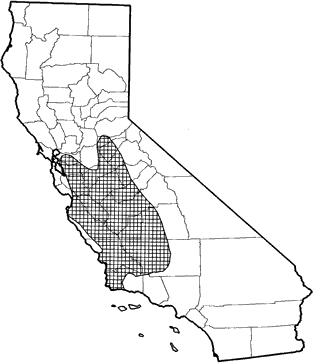
Heermann's Kangaroo Rat
Distribution, Abundance, and Seasonality
Heermann's kangaroo rat is distributed in the foothills of the Sierra Nevada from Fresno to El Dorado cos., in the San Joaquin Valley, and in the Coast Ranges south of San Francisco Bay to Point Conception. It is common in annual grassland, coastal scrub, mixed and montane chaparral, and early successional stages (sparse to open canopy) of valley foothill hardwood and valley foothill hardwood-conifer habitats. Uncommon in a variety of other habitats.

Range Map
Specific Habitat Requirements
Feeding: Largely granivorous, but also eats forbs and green grasses seasonally. Some preferred food plants are soft chess, filaree, red brome, foxtail fescue, mouse barley, wild oats, lupine, lotus, and clover (Tappe 1941, Fitch 1948). Tendency to cache food apparently reduced relative to other heteromyids.
Cover: Well-drained soil is required. Preferred burrowing substrate is fine, deep soil (Tappe 1941), although shallow, coarse, and rocky soil also may be used. In rocky soils, may rely on abandoned burrows (Fitch 1948). Burrow complexity, including length, tiering, and number of entrances, seems to depend on ease of excavation. Loose, dry soil near burrow entrance used for dust bathing.
Reproduction: Young are born in nest of dried grass, roots of grass, and seed husks, in a burrow chamber 30-75 cm (12-30 in) below the surface (Ingles 1947).
Water: Apparently can survive without drinking water, but in lab readily accepts leafy vegetation and may drink. Probably receives water from food and dew under natural conditions.
Pattern: Frequents dry, grassy plains, with partly open, friable soil; occurs on hillsides, knolls, and ridges with sparse to moderate chaparral cover (Grinnell 1933, Fitch 1948). Has comparatively broad habitat requirements (Kelt 1988).
Species Life History
Activity Patterns: Nocturnal. Active yearlong.
Seasonal Movements / Migration: None.
Home Range: In San Joaquin Valley, densities of up to 17/ha (7/ac) reported, but annual fluctuations were great. Most marked individuals ranged within 30-120 m (100-400 ft) over the course of a year or more (Fitch 1948).
Territory: Aggressively solitary, although perhaps one of the least so of California heteromyids. Caged animals commonly sleep in the same nest.
Reproduction: Breeds from February into October, with peak in April (Fitch 1948). Litter size usually 2 or 3 young (range 2-5) (Tappe 1941, Fitch 1948). Litter size in months of high food availability (April, May) higher than other mo. Adults normally breed twice a yr, but 3 litters also possible. Weaning at 17-25 days (Tappe 1941). Young may breed at less than 2 mo of age. Females born in first litter of spring may have 2 litters of their own before winter (Ingles 1965).
Niche: The principal predators may be rattlesnakes, and gopher snakes, though D. heermanni also is an important prey item for owls, badgers, foxes, coyotes, and other predatory mammals (Fitch 1948).
Comments: The Endangered Morro Bay kangaroo rat (D. h. morroensis) from near Morro, San Luis Obispo Co., apparently has declined in numbers by more than 80% in the past 20 yr because of loss, fragmentation, and degradation of habitat (Kelt 1988).
Sources & References
California Department of Fish and Game, 1999.
California's Wildlife, Sacramento, CA.
Written by: P. Brylski, reviewed by: H. Shellhammer, edited by: R. Duke
Fitch, H. S. 1948. Habits and economic relationships of the Tulare kangaroo rat. J. Mammal. 29:5-35. Grinnell, J. 1922. A geographical study of the kangaroo rats of California. Univ. Calif. Publ. Zool. 24:1-124. Grinnell, J. 1933. Review of the recent mammal fauna of California. Univ. Calif. Publ. Zool. 40:71-234. Ingles, L. G. 1947. Mammals of California. Stanford Univ. Press, Stanford, Calif. 258pp. Ingles, L. G. 1965. Mammals of the Pacific states. Stanford Univ. Press, Stanford, CA. 506pp. Kelt, D. A. 1988. Dipodomys heermanni. Mammal. Species No. 323. 7pp. Patton, J. L., H. MacArthur, and S. Y. Yang. 1976. Systematic relationships of the four-toed populations of Dipodomys heermanni. J Mammal. 57:159-163. Tappe, D. T. 1941. Natural history of the Tulare kangaroo rat. J. Mammal. 22:117-147.
California Animal Facts | California's Wildlife